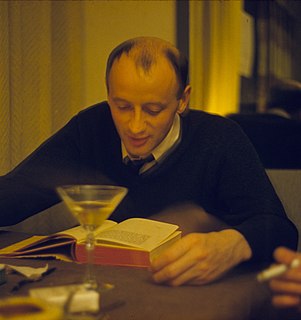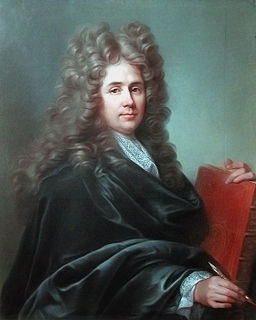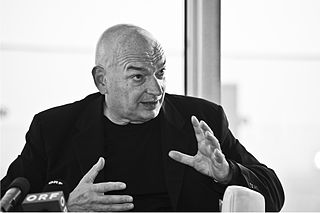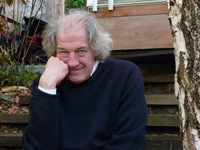
Eamonn Kevin Roche was an Irish-born American Pritzker Prize-winning architect. He has been responsible for the design/master planning for over 200 built projects in both the U.S. and abroad. These projects include eight museums, 38 corporate headquarters, seven research facilities, performing arts centers, theaters, and campus buildings for six universities. In 1967 he created the master plan for the Metropolitan Museum of Art, and henceforth designed all of the new wings and installation of many collections including the recently reopened American and Islamic wings.

La Grande Arche de la Défense is a monument and building in the business district of La Défense and in the commune of Puteaux, to the west of Paris, France. It is usually known as the Arche de la Défense or simply as La Grande Arche. A 110-metre-high (360 ft) cube, La Grande Arche is part of the perspective from the Louvre to Arc de Triomphe. The distance from La Grande Arche to Arc de Triomphe is 4 km.

Jules Hardouin-Mansart was a French Baroque architect and builder whose major work included the Place des Victoires (1684-1690); Place Vendôme (1690); the domed chapel of Les Invalides (1690), and the Grand Trianon of the Palace of Versailles. His monumental work was designed to glorify the reign of Louis XIV of France.

Philibert de l'Orme was a French architect and writer, and one of the great masters of French Renaissance architecture. His surname is also written De l'Orme, de L'Orme, or Delorme.

Auguste Perret was a French architect and a pioneer of the architectural use of reinforced concrete. His major works include the Théatre des Champs-Élysées, the first Art Deco building in Paris; the Church of Notre-Dame du Raincy (1922–23); the Mobilier Nationale in Paris (1937); and the French Economic, Social and Environmental Council building in Paris (1937–39). After World War II he designed a group of buildings in the centre of the port city of Le Havre, including St. Joseph's Church, Le Havre. to replace buildings destroyed by bombing during World War II. His reconstruction of the city is now a World Heritage Site.

Christian de Portzamparc is a French architect and urbanist. He graduated from the École Nationale des Beaux Arts in Paris in 1970 and has since been noted for his bold designs and artistic touch; his projects reflect a sensibility to their environment and to urbanism that is a founding principle of his work. He won the Pritzker Prize in 1994.

Jean-Baptiste Alexandre Le Blond was a French architect and garden designer who became the chief architect of Saint Petersburg in 1716.

Robert de Cotte was a French architect-administrator, under whose design control of the royal buildings of France from 1699, the earliest notes presaging the Rococo style were introduced. First a pupil of Jules Hardouin-Mansart, he later became his brother-in-law and his collaborator. After Hardouin-Mansart's death, de Cotte completed his unfinished projects, notably the royal chapel at Versailles and the Grand Trianon.

Jean-François-Thérèse Chalgrin was a French architect, best known for his design for the Arc de Triomphe, Paris.

I as in Icarus is a 1979 French thriller film directed by Henri Verneuil.

Jean-Claude Nicolas Forestier was a French landscape architect, who trained with Adolphe Alphand and became conservator of the promenades of Paris.

ENGIE is a French multinational electric utility company, headquartered in La Défense, Courbevoie, which operates in the fields of energy transition, electricity generation and distribution, natural gas, nuclear, renewable energy and Petroleum.

The Métropole du Grand Paris is an administrative structure for cooperation covering the City of Paris and its nearest suburbs that surround it. The métropole came into existence on January 1, 2016 and comprises 131 communes. It includes the City of Paris, all 123 communes in the surrounding inner-suburban departments of the Petite Couronne, plus seven communes in two of the outer-suburban departments, including the communes of Argenteuil in Val-d'Oise, and Paray-Vieille-Poste in Essonne, the latter of which covers part of Orly airport. Part of the métropole comprised the Seine department, which existed from 1929 to 1968. Grand Paris covers 814 square kilometers and has a population of 7 million.

Jean Nouvel is a French architect. Nouvel studied at the École des Beaux-Arts in Paris and was a founding member of Mars 1976 and Syndicat de l'Architecture. He has obtained a number of prestigious distinctions over the course of his career, including the Aga Khan Award for Architecture, the Wolf Prize in Arts in 2005 and the Pritzker Prize in 2008. A number of museums and architectural centres have presented retrospectives of his work.

Jean-Paul Viguier is a French architect. He is considered one of the world's leading architects and one of the few French ones to work extensively outside of Europe.
The Grands Projets of François Mitterrand was an architectural program to provide modern monuments in Paris, the city of monuments, symbolizing France’s role in art, politics, and economy at the end of the 20th century. The program was initiated by the 21st President of France while he was in office. Mitterrand viewed the civic building projects, estimated at the time to cost the Government of France 15.7 billion FF, both as a revitalisation of the city, as well as contemporary architecture promoted by Socialist Party politics. The scale of the project and its ambitious nature was compared to the major building schemes of Louis XIV.

Alexandre Chemetoff is a French architect, urban planner and landscape artist. In 2000, he was awarded the Grand Prix de l'urbanisme. His approach to project development is to visit the site, walk it, and then connect it with other experiences.

The Petit Luxembourg is a French hôtel particulier, currently the residence of the president of the French Senate. It is located at 17–17 bis, rue de Vaugirard, just west of the Luxembourg Palace, which currently serves as the seat of the Senate, in the 6th arrondissement of Paris. Originally built around 1550 to the designs of an unknown architect, it is especially noted for the surviving Rococo interiors designed in 1710–1713 by the French architect Germain Boffrand. Further west, at 19 rue de Vaugirard, is the Musée du Luxembourg.




















